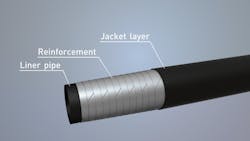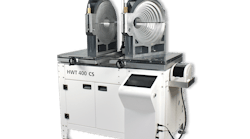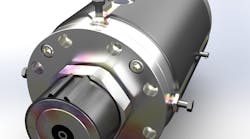KraussMaffei Berstorff has developed a pair of new extrusion technologies for producing high-performance thermoplastic composite pipes suitable for use in the oil and gas industry.
The first is the KM-3L RKW 250 F3 die head that produces a three-layer PE pipe with a functional inner layer made of polyamide (PA) 12, a nylon that can be extruded into pipe, tubes and hoses to carry vapors, fuel and other liquids without decomposing. The pipe is especially suited for transporting corrosive and abrasive materials, KraussMaffei Berstorff said.
“It is a new concept of a die head in which we have constructed the melt channels in a new way, and we also make sure that the channels are temperature-insulated from each other,” said Matt Sieverding, the company’s president of extrusion technology.
While PA 12 is very resistant to chemicals and abrasion, it is substantially more expensive than PE. A KraussMaffei Berstorff development team set out to find a way to combine the materials to gain the benefit of PA 12 while minimizing costs.
For complete bonding of the PA 12 and PE, an additional bonding layer is required, Sieverding said.
KraussMaffei Berstorff first demonstrated the die head in June using equipment that produces pipe with an interior diameter ranging from 2 inches to 6 inches and a maximum operating pressure of up to 1,500 pounds per square inch (psi).
The demonstration line uses KraussMaffei’s KME 75-36 B/R, KME 45-36 B/R and KME 30-25 D/C single-screw extruders. Throughputs varied by material — 1 ,764 pounds per hour for PE, 66 pounds per hour for the bonding agent and 397 pounds per hour for PA 12. Models can vary, based on users’ needs.
In addition to the new three-layer die head, KraussMaffei Berstorff developed what it calls the TCP (thermoplastic composite pipes) production line for wrapping pipes with fiberglass-reinforced unidirectional tape.
The automated system moves finished PE pipe through infrared ovens. The tape is then attached at two successive winding stations, and infrared ovens for each layer ensure complete bonding of the tape to the pipe. The final step is the jacketing or sheathing of the wrapped pipe with a protective outer layer of PE.
KraussMaffei Berstorff can offer an entire turnkey production system and tailor it to a customer’s needs. For example, most customers buying a TCP production line would need a higher capacity and longer line than KraussMaffei’s demonstration model.
“This is a real benefit to our customers as lengthy and time-consuming process steps are drastically shortened,” Sieverding said of the TCP production line. “The fiber-reinforced pipes are excellently suited for the challenging safety requirements and high-pressure loads in the oil and gas industry.”
On land, the working pressure in oil and gas industry pipes can reach nearly 2,200 psi. For offshore use, the pipe can be built to withstand a pressure of about 7,300 psi.
Bruce Geiselman, senior staff reporter
Contact:
Krauss-Maffei Corp. Florence, Ky., 859-283-0200, www.kraussmaffeigroup.us







